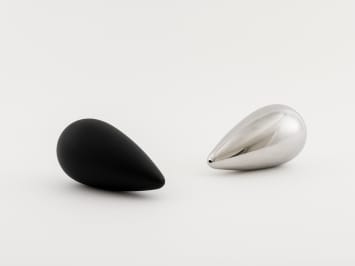Popping in and out of being, electrons exist as probability clouds. They can also be entangled to exist in two different parts of the universe at the same time. What Einstein called “spooky action at a distance,” these electrons cease to be distinct objects and function as one system that inhabits two states simultaneously. Beyond our common-sense perception of reality, the quantum dimension feels strange and mysterious.
Unlike digital computers that store information as electrical signals in binary bits, quantum computers use subatomic particles, such as electrons; in particular, entangled electrons are used to encode data in multiple states at once, giving the quantum computer its incredible potential. Based on the shapes of hydrogen electron probability clouds, the three dimensional forms use the language of sculpture to bring the quantum experience into the realm of our senses.
Sculptures can shift perception and open up alternate ways of thinking and imagining new worlds. Entangling two electron cloud forms, the paired sculptures are interconnected — one existing in opposite phenomenological effect to the other; the ultra-matte black stainless-steel pieces absorb light while their mirror finish counterparts reflect light. Activating one’s memory and imagination, the work implicates the spectator in its entanglement; seeing one form triggers the mind to conjure its inverted twin, in an instant, one is transported into the quantum dimension.
Three two-way mirror glass sheets are embedded with images of various quantum computing technologies using the wet-plate collodion photographic process. The translucent quality of the two-way mirrors gives the photographic works a sense of dimensionality while retaining their reflective property. Constructed as portal-like screens, the images on mirror reflect the “world of the human” while providing a glimpse into the quantum realm like dream machines.
Quantum computers have the potential to model reality in a range of scenarios, including weather systems, viral behavior, information networks. The future applications of quantum computing will be revolutionary, which may affect climate change, global health, communication, and other issues on the planetary scale. As Richard Feynman said, “Nature isn’t classical, … if you want to make a simulation of nature, you’d better make it quantum mechanical.”
Conversations Program
Alice Wang will also participate in the Art Basel Hong Kong 2023 Conversations program as the moderator of the conversation “New Bodies, New Natures: Figure and Land as Site and Situation”.
Time: Wednesday, March 22, 2023, 12:30 – 2:00 pm
Venue: Auditorium, N101B, Level 1, Hong Kong Convention and Exhibition Centre, 1 Expo Drive, Wan Chai, Hong Kong
UBS Silent Insight Program
Capsule Shanghai is also pleased to announce that Leelee Chan will participate in the artist conversation as part of the Art Basel Hong Kong 2023 – UBS Silent Insight Program.
Time: Wednesday, March 22, 2023, 3:00 – 3:30 pm
Venue: UBS Lounge, Level 4, Hong Kong Convention and Exhibition Centre, 1 Expo Drive, Wan Chai, Hong Kong


